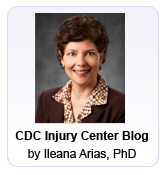Working to Prevent Sexual Violence
April is Sexual Assault Awareness Month and people throughout the world participate in Denim Day, a campaign to raise awareness about rape and sexual assault. Wearing denim as a sign of protest, participants strive to end sexual violence.
This month in particular, our partners at the National Sexual Violence Resource Center and others raise public awareness about sexual violence. Unfortunately, sexual violence can happen anywhere, including the workplace. Employees and employers have an important  role to play in preventing sexual violence. The focus of this year’s effort, “Respect Works,” highlights that respectful behavior in individual and organizational roles helps maintain safe, healthy communities and workplaces.
role to play in preventing sexual violence. The focus of this year’s effort, “Respect Works,” highlights that respectful behavior in individual and organizational roles helps maintain safe, healthy communities and workplaces.
Sexual violence is a significant public health issue. Stopping sexual violence from happening in the first place – prevention – is the goal for all of us at the Injury Center. We are leading research on primary prevention and early intervention, and once we learn more through research, we move science into practice. As effective strategies to prevent sexual violence are identified, we determine how best to share these with the public health community so that they are lived out.
Through our national Rape Prevention and Education (RPE) program and EMPOWER program we support the development, implementation, and evaluation of sexual violence prevention strategies in all 50 states, the District of Columbia, Puerto Rico, and six U.S. territories. Our RPE and EMPOWER partners are the frontline practitioners working to build capacity and implement strategies that will ultimately prevent sexual violence perpetration and victimization.
With our emphasis on sexual assault awareness this month, we recognize the important work that has been done by many of our partners. This work has ensured that we have crisis intervention, victim advocacy, and health services critical to the long-term well being of those affected by sexual violence. Through focused research and national sexual violence prevention programs, CDC contributes to sexual violence prevention by promoting efforts to modify or eliminate the individual, relationship, community and societal influences that result in perpetration, victimization, and bystander attitudes that allow sexual violence to occur.
Send me a comment today.
Posted by: Ileana Arias, Tuesday, Apr 22, 2009, 11:33 am ETT
Previous Blogs
Take Action to Protect Our Youth from Traumatic Brain Injury
Along with many others, I was shocked to learn about the recent death of actress Natasha Richardson. Ms. Richardson fell while taking skiing lessons on a beginner’s slope. Although she hit her head, she reportedly got up from the fall and declined any immediate medical treatment since she didn’t lose consciousness and felt fine. But soon afterward the world learned what we at CDC already knew – even a seemingly minor bump to the head can result in a significant traumatic brain injury.
Posted by: Ileana Arias, Tuesday, Feb 18, 2009, 01:10 pm ETT
Contact Us:
- Centers for Disease Control and Prevention
National Center for Injury Prevention and Control (NCIPC)
4770 Buford Hwy, NE
MS F-63
Atlanta, GA 30341-3717 - 800-CDC-INFO
(800-232-4636)
TTY: (888) 232-6348
24 Hours/Every Day - cdcinfo@cdc.gov

